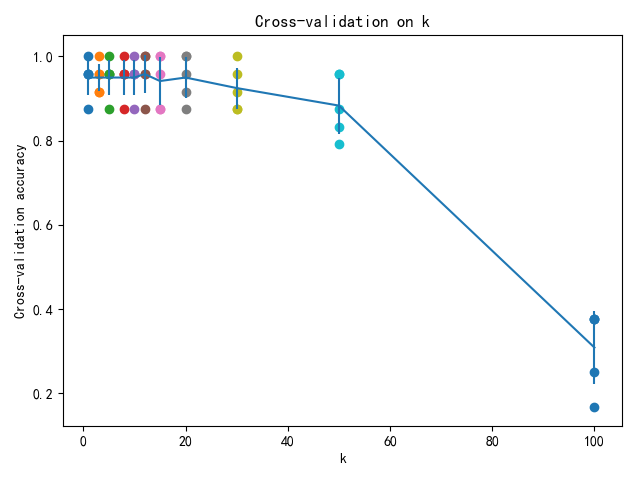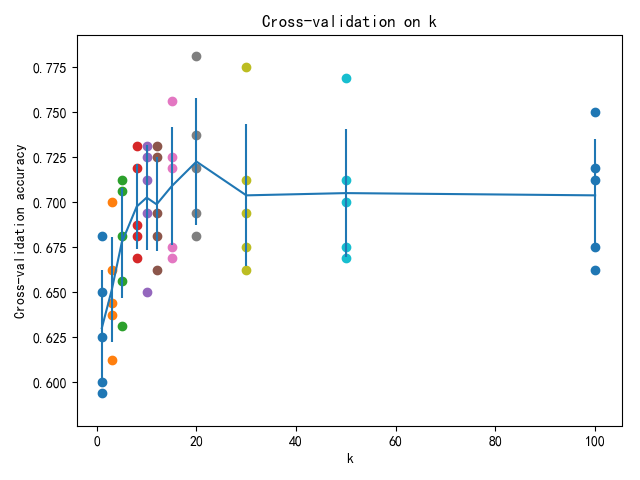1
2
3
4
5
6
7
8
9
10
11
12
13
14
15
16
17
18
19
20
21
22
23
24
25
26
27
28
29
30
31
32
33
34
35
36
37
38
39
40
41
42
43
44
45
46
47
48
49
50
51
52
53
54
55
56
57
58
59
60
61
62
63
64
65
66
67
68
69
70
71
72
73
74
75
76
77
78
79
80
81
82
83
84
85
86
87
88
89
90
91
92
93
94
95
96
97
98
99
100
101
102
103
104
105
106
107
108
109
110
111
112
113
114
115
116
117
118
119
120
121
122
123
124
125
126
127
128
129
130
131
132
133
134
135
136
137
138
139
140
141
142
143
144
145
146
147
148
149
|
from builtins import range
from classifier.knn_classifier import KNN
import pandas as pd
import numpy as np
from sklearn import utils
from sklearn.model_selection import train_test_split
import matplotlib.pyplot as plt
import warnings
warnings.filterwarnings("ignore")
def load_iris(iris_path, shuffle=True, tsize=0.8):
"""
加载iris数据
"""
data = pd.read_csv(iris_path, header=0, delimiter=',')
if shuffle:
data = utils.shuffle(data)
species_dict = {
'Iris-setosa': 0,
'Iris-versicolor': 1,
'Iris-virginica': 2
}
data['Species'] = data['Species'].map(species_dict)
data_x = np.array(
[data['SepalLengthCm'], data['SepalWidthCm'], data['PetalLengthCm'], data['PetalWidthCm']]).T
data_y = data['Species']
x_train, x_test, y_train, y_test = train_test_split(data_x, data_y, train_size=tsize, test_size=(1 - tsize),
shuffle=False)
return x_train, x_test, y_train, y_test
def load_german_data(data_path, shuffle=True, tsize=0.8):
data_list = pd.read_csv(data_path, header=None, sep='\s+')
data_array = data_list.values
height, width = data_array.shape[:2]
data_x = data_array[:, :(width - 1)]
data_y = data_array[:, (width - 1)]
x_train, x_test, y_train, y_test = train_test_split(data_x, data_y, train_size=tsize, test_size=(1 - tsize),
shuffle=shuffle)
y_train = np.array(list(map(lambda x: 1 if x == 2 else 0, y_train)))
y_test = np.array(list(map(lambda x: 1 if x == 2 else 0, y_test)))
return x_train, x_test, y_train, y_test
def compute_accuracy(y, y_pred):
num = y.shape[0]
num_correct = np.sum(y_pred == y)
acc = float(num_correct) / num
return acc
def cross_validation(x_train, y_train, k_choices, num_folds=5, Classifier=KNN):
X_train_folds = np.array_split(x_train, num_folds)
y_train_folds = np.array_split(y_train, num_folds)
k_to_accuracies = {}
for k in k_choices:
k_accuracies = []
for i in range(num_folds):
x_folds = X_train_folds.copy()
y_folds = y_train_folds.copy()
x_vals = x_folds.pop(i)
x_trains = np.vstack(x_folds)
y_vals = y_folds.pop(i)
y_trains = np.hstack(y_folds)
classifier = Classifier()
classifier.train(x_trains, y_trains)
y_val_pred = classifier.predict(x_vals, k=k)
k_accuracies.append(compute_accuracy(y_vals, y_val_pred))
k_to_accuracies[k] = k_accuracies
return k_to_accuracies
def plot(k_choices, k_to_accuracies):
for k in k_choices:
accuracies = k_to_accuracies[k]
plt.scatter([k] * len(accuracies), accuracies)
accuracies_mean = np.array([np.mean(v) for k, v in sorted(k_to_accuracies.items())])
accuracies_std = np.array([np.std(v) for k, v in sorted(k_to_accuracies.items())])
plt.errorbar(k_choices, accuracies_mean, yerr=accuracies_std)
plt.title('Cross-validation on k')
plt.xlabel('k')
plt.ylabel('Cross-validation accuracy')
plt.show()
if __name__ == '__main__':
data_path = '/home/zj/data/german/german.data-numeric'
x_train, x_test, y_train, y_test = load_german_data(data_path, shuffle=True, tsize=0.8)
x_train = x_train.astype(np.double)
x_test = x_test.astype(np.double)
mu = np.mean(x_train, axis=0)
var = np.var(x_train, axis=0)
eps = 1e-8
x_train = (x_train - mu) / np.sqrt(var + eps)
x_test = (x_test - mu) / np.sqrt(var + eps)
k_choices = [1, 3, 5, 8, 10, 12, 15, 20, 30, 50, 100]
k_to_accuracies = cross_validation(x_train, y_train, k_choices)
for k in sorted(k_to_accuracies):
for accuracy in k_to_accuracies[k]:
print('k = %d, accuracy = %f' % (k, accuracy))
plot(k_choices, k_to_accuracies)
accuracies_mean = np.array([np.mean(v) for k, v in sorted(k_to_accuracies.items())])
k = k_choices[np.argmax(accuracies_mean)]
print('最好的k值是:%d' % k)
classifier = KNN()
classifier.train(x_train, y_train)
y_test_pred = classifier.predict(x_test, k=k)
y_test_acc = compute_accuracy(y_test, y_test_pred)
print('测试集精度为:%f' % y_test_acc)
|

